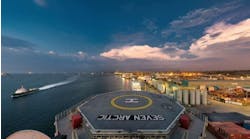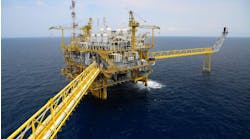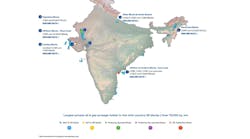Ted Moon, Houston
DeepOcean taps GRL simulator
Subsea simulator company General Robotics Ltd. (GRL) won an order for its ROVolution simulator from subsea services provider DeepOcean AS. GRL says ROVolution is a real-time, PC-based simulator which hydrodynamically models any ROV, and is used for ROV pilot and manipulator operator training, subsea task planning, and access simulation.
The simulator is used to train pilots in the North Sea and the Mediterranean for DeepOcean’s KystdesignInstaller and Supporter ROVs.
DeepOcean has heavy workloads for its services, and experienced ROV pilots are difficult to find and to retain. The company reports that it takes a new pilot, with no prior ROV experience, around two years of training to gain DeepOcean’s certificate of competence.
The company initially relied on recruiting experienced ROV pilots and then cross-training them on theInstallers offshore, but on-the-job training became too slow and expensive as the workload grew. To streamline the training process onshore, GRL adapted its generic ROVolution simulator for the Installer ROVs.
GRL worked with Kystdesign and DeepOcean to link command signals from theInstaller control console to the ROVolution simulator so pupils can sit at their usual control console and feel as though they are piloting the real Installer.
GRL reports that pupils using the ROVolution simulator can log training hours more quickly and cheaply than using theInstallers at sea, as a real work environment typically is not the best place to train pilots. DeepOcean plans to train 35 additional pilots with no previous ROV experience by the end of the year. In addition, DeepOcean will extend use of ROVolution to train pilots on new tasks and scenarios, such as job simulations, before they go to sea.
“With ROVolution we believe we have a simulator that soon will pay for itself - more qualified pilots can be deployed more flexibly which makes our offshore operations more efficient,” says Sven Storesund, superintendent ROV/Survey at DeepOcean. “We can give existing pilots refresher and scenario training onshore. A unique aspect of the simulator is that you can play with new techniques which would be prohibitively expensive, and possibly dangerous, using the ROV for real.”
“DeepOcean is an innovative, agile operator looking for best-in-class technology to give a competitive edge in a technology-based industry,” says Dr. Jason Tisdall, director of business development, General Robotics Ltd. “Working with them has given us a detailed insight into the requirements of smaller operators. DeepOcean knows what we can do, and it now is considering upgrading to our tether management system, and Navipac navigation and survey software.”
Marathon gets go-ahead for manned subsea operations on Alvheim
Marathon Petroleum Norge AS has permission from the Norwegian government to perform manned subsea operations on Alvheim in connection with development of the oil and gas field.
The Alvheim development was approved in October 2004, and is a joint development of the Kameleon, Kneler and Boa discoveries. The discoveries are in the Norwegian North Sea, west of the Heimdal field. Alvheim will be developed using seabed installations tied into a floating production and oil storage vessel.
Planned work was set to kick off mid-July 2006, and diving operations will last approximately 60 days.
Dolphin reports no construction complaints
Abu Dhabi-based Dolphin Energy Ltd. says it received no objections from any state regarding the construction of the pipeline that passes within the maritime zones of the U.A.E. and Qatar.
Dolphin received approvals from the U.A.E. and Qatar in 2004 to construct the pipeline, which, as of press time, was scheduled for completion in August. The completion of this pipeline reportedly will facilitate transportation of gas from Ras Laffan in Qatar to Taweelah in U.A.E.
Dolphin was founded with the goals of creating substantial energy projects and developing long-term economic wealth and new business opportunities for the six Gulf Cooperation Council countries. In accordance with these goals, Dolphin started a strategic initiative known as the “Dolphin Project”. The project involves production and processing of natural gas from Qatar’s North field, and subsequent transportation of the dry gas by subsea pipeline across joint U.A.E.-Qatari waters to the U.A.E.
Dolphin’s first initiative, the Al Ain-to-Fujairah Pipeline, came onstream in January 2004.The pipeline supplies the Fujairah Water and Power Plant on the U.A.E.’s East Coast, initially with natural gas from Oman and subsequently with Dolphin gas from Qatar. In May 2005, Dolphin began to supply natural gas to the U.A.E. Emirate of Ras Al Khaimah. The gas is being delivered via a tie-in near Qidfa between Dolphin’s Al Ain-Fujairah pipeline and the existing Emarat gas pipeline network.
Dolphin Energy is owned 51% by Mubadala Development Co., on behalf of the government of Abu Dhabi, and 24.5% each by Total of France and Occidental Petroleum of the US.





